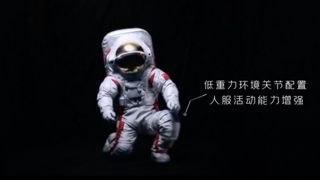China has strutted out its moon-landing spacesuit, unveiling its design in a ceremony Saturday (Sept. 28) in southwest China’s Chongqing Municipality.
A technician put the spacesuit — which China aims to start using on crewed moon missions by 2030 — through its paces, showcasing various movements and gestures, including climbing the rungs of a ladder.
The overall design of the moon-landing suit is inspired by traditional Chinese armor, underscoring the suit’s rugged and resolute appearance. It also features ribbons, which have always been an important element in the design of Chinese spacesuits.
Multi-use suit
The new lunar suit is an evolution of the Feitian, China’s first indigenous spacesuit. Feitian means “flying in the sky” and is the name of a legendary Buddhist goddess.
Related: China unveils video of its moon base plans, which weirdly includes a NASA space shuttle
“The Feitian extravehicular activity suit is designed for use in low Earth orbit, where astronauts float in a microgravity environment,” said Zhang Wanxin, director of the Spacesuit Engineering Office and deputy chief designer of the Astronaut System at the China Astronaut Research and Training Center.
“Therefore, we chose the ribbon element to convey a sense of free flow,” Zhang told state broadcaster China Central Television (CCTV). “The moon-landing suit is designed for lunar explorations such as walking and working on the moon’s surface, so we would also like to convey a strong-willed and unswerving feeling, which we integrated organically into the suit’s design.”
Following the suit demonstration, Yang Liwei, deputy chief designer of China’s crewed space program and China’s first astronaut, together with the technician, launched a public campaign to name the new moon spacesuit. This campaign will close on Oct. 31, 2024.
Experts on China’s first-ever lunar spacesuit provided additional details on the lightweight, flexible garment.
According to CCTV, the suit’s attributes include:
- A comprehensively protective fabric that shields against the harsh thermal environment and lunar dust
- A panoramic glare-proof visor for improved vision
- Two cameras on the sides of the helmet for video recording
- A multi-functional control console on the chest that…
Click Here to Read the Full Original Article at Space…

